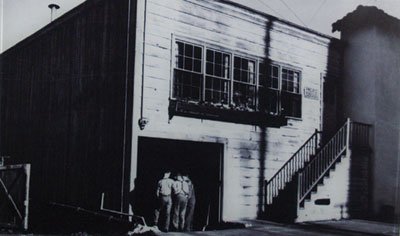The most important building on Cannery Row is a ramshackle
ancient edifice
butting up to the Monterey Bay Aquarium. Tourists hardly give
it a glance, but that run-down dwelling once served as the
laboratory for the world’s greatest marine biologist.
The most important building on Cannery Row is a ramshackle ancient edifice butting up to the Monterey Bay Aquarium. Tourists hardly give it a glance, but that run-down dwelling once served as the laboratory for the world’s greatest marine biologist.
A few weeks ago, I took Calvin Nuttall, an 11-year-old Morgan Hill boy, for a day’s adventure at the world-famous aquarium. On our way to get lunch, we stopped outside 800 Cannery Row and I explained how Edward Ricketts was an ocean scientist who lived and worked there long ago. “If it hadn’t been for ‘Doc’ Ricketts, there never would have been a Monterey Bay Aquarium to teach folks about our oceans and the critters that live in them,” I told Nuttall.
Born in 1897, Ricketts grew up in Chicago in a middle-class family. He was drafted by Uncle Sam in 1917 and served in the Army Medical Corps where he learned to hate government bureaucracy. After World War I, he studied zoology at the University of Chicago but dropped out before earning a degree.
Married and with a new-born son, he moved to Northern California in 1923 to set up the Pacific Biological Laboratories in downtown Pacific Grove with a college buddy. The next year, he became sole owner of the biological supply house and relocated the business to 800 Ocean View Avenue in Monterey. (When the street became a tourist attraction, its name was officially changed to Cannery Row).
At night, writers and artists often gathered for a gabfest among the marine specimens that Ricketts had collected in his daily jaunts into the swelling tide pools. Well lubricated by wine, beer and other intoxicating brews, they poured forth their blue-collar profundity in free-for-all discourses. Among the more famous were a shy young writer from Salinas named John Steinbeck and a confident scholar from New York named Joseph Campbell. Steinbeck immortalized his marine biologist friend as “Doc,” the protagonist in the novels Cannery Row and Sweet Thursday, as well as in the nonfiction marine biology adventure “The Log from the Sea of Cortez.”
Ricketts had a radical idea about marine biology research. He thought the best way to understand a creature was to observe it in its actual home environment. The traditional biologists of his day preferred to study sea animals kept in sterile tanks far from the ocean. These old-school scientists thought that studying a species simply meant dissecting it and figuring out its taxonomic classification. But Doc Ricketts had a research method that proved far more interesting for scientific knowledge. Wearing hip boots, he would wade into the cold waves and closely observe an animal’s relationship with other organisms and environmental conditions. Adventuring into the natural surroundings taught him how all life on our planet is connected in an intricate ecological web of survival. Today, Ricketts’s radical research idea is accepted as good science.
Perhaps Rickett’s ecological model influenced how the biologist looked at humanity, too. No doubt the philosopher-ecologist discussed with Steinbeck and Campbell the intricate webs connecting the stories of human cultures throughout the world and throughout the ages. Well lubricated with a jug of cheap vino, his laboratory soirees certainly influenced Steinbeck’s literature as well as Campbell’s analysis of common patterns in mythology.
Encouraged by Steinbeck and Campbell, Ricketts wrote a book. Published in 1939, his “Between Pacific Tides” is considered a classic study of California’s intertidal marine ecology. Now in its fifth edition, the publication is a highly-readable work providing pioneering observations on ocean critters in their home habitat.
In articles he wrote for a Monterey newspaper, Ricketts also analyzed the local sardine fishing industry. He showed quantitatively that the harvests would decline as intense fishing hauls exhausted them. As Ricketts predicted, the Monterey Bay waters ran out of sardines. One by one, each factory along Cannery Row shut down. People asked the marine biologist where the fish had gone. “They’re in cans,” he told them.
A former cannery serves today as the site of the prestigious Monterey Bay Aquarium. Located next to Ricketts’s weather-beaten Pacific Biological Laboratories, the tourist attraction teaches visitors how all life – including human life – is connected to ecology’s intricate web. A small display near the main entrance showcases some of the ocean scientist’s lab specimens.
The Monterey Bay Aquarium is Ed Ricketts’s spiritual legacy. The marine biologist would no doubt be pleased with how it educates people about protecting our world’s precious oceans. That’s what I thought as I snapped a photo of Calvin Nuttall posing on the exterior stairs leading up to “Doc’s” dilapidated old laboratory, the most important building on Cannery Row.












